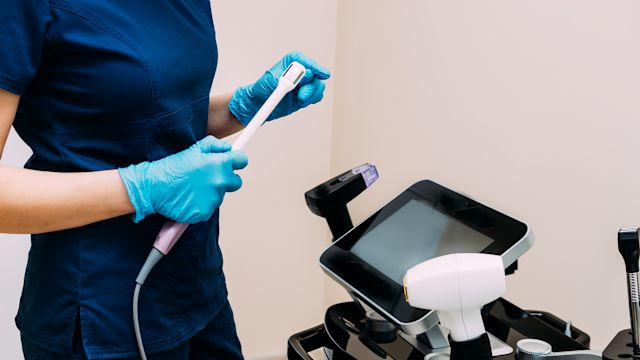Updated on September 30, 2025.
Vaginal rejuvenation covers aesthetic and functional procedures that aim to correct and restore the structure and integrity of the vagina and tissues surrounding it. It’s not an actual medical term but a marketing term geared toward people who’ve experienced vaginal issues or changes due to:
- Aging
- Childbirth
- Genetics
- Menopause
- Physical trauma
For instance, vaginal birth can result in the vagina feeling looser and laxer. This may also occur during menopause since levels of the hormone estrogen wane around this time frame.
This can cause vaginal atrophy. The official term for this is genitourinary syndrome of menopause (GSM). GSM can cause the tissues that line the inside of the vagina to become dry, thin, and inflamed. The vaginal walls also grow more flaccid.
Some people feel dissatisfied with the look and feel of their vaginas. For others, these changes can lead to:
- Decreased sensation or friction felt during sex due to vaginal laxity
- Dyspareunia or painful sex due to vaginal dryness and tissue thinning
- Stress urinary incontinence or not being able to control the release of urine when pressure is placed on the bladder due to weaker pelvic and vaginal muscles
- Vaginal itching due to dryness and lower estrogen levels
As such, some people look to various procedures to strengthen and tighten the vaginal wall and improve its elasticity. They also seek to rehydrate the vaginal mucosa, the vagina’s mucous-producing membranes.
Surgery can alter or rebuild the pelvic floor and vaginal tissues and structures. But some people prefer less invasive options. This is where energy-based vaginal rejuvenation products and procedures come in.
Certain energy-based devices claim to lift and tighten the skin. These treatments may result in modest to more noticeable results.
But this depends on the type of energy-based procedure, according to the American Academy of Dermatology Association. These can range from noninvasive to minimally invasive.
You’re likely to notice results with more invasive procedures. But bear in mind that use of these devices inside the vaginal canal or vulva (outer part of the female genitals) involves newer approaches that haven’t been fully vetted.
Some research suggests these nonsurgical procedures may be safe and effective in the short term. But their long-term effectiveness and safety profile aren’t yet known.
What is energy-based vaginal rejuvenation?
Each type of energy-based vaginal rejuvenation device works differently. In general, these devices use laser or radiofrequency (RF) technology.
They heat the top layers of vaginal tissue to produce and remodel proteins made by your tissues called collagen and elastin. Together, these proteins create a network of fibers that help tone and tighten the vagina.
The procedures aim to regenerate the mucosa, which helps the vagina stay moist. It may also prompt growth of new blood vessels and boost blood flow to the area.
All said, energy-based vaginal rejuvenation procedures have been shown to be most effective for:
- Mild pelvic organ prolapse, which causes the bladder to drop slightly into the vagina
- Mild to moderate stress urinary incontinence
- Overactive bladder
- Problems achieving orgasm
- Vaginal dryness and decreased lubrication
- Vaginal laxity
They usually cause little to no pain. But you may feel warmth or a quick zap like a rubber band snapping as your healthcare provider (HCP) moves the device along the treatment area. In most cases, you won’t need anesthesia. If needed, your HCP can apply a topical numbing agent.
Each session can take 5 to 30 minutes, depending on the:
- Treatment areas
- Procedure and device type
- Device intensity or strength used
You usually won’t need to take time off to recover. The redness and swelling often last for a few days at most. But you’ll need to abstain from sex for about three days to allow the swelling to go down and the area to heal.
Vaginal rejuvenation sessions are scheduled about six weeks apart. It often takes multiple sessions to notice a difference or achieve the results you want. Results are often temporary.
What is laser vaginal rejuvenation?
These vaginal rejuvenation treatments deliver laser energy to the vaginal wall. Your HCP inserts a probe or wand into the vagina or guides it across the outside of it. They gently rotate and glide the probe back and forth to distribute heat to the target area.
What is radiofrequency vaginal rejuvenation?
RF devices for vaginal rejuvenation use electromagnetic waves to deliver focused heat to the target area. This may help tighten the vagina and improve its sensitivity.
RF devices are classified based on the number of electrodes or active electrical poles used for treatment. They can be:
- Monopolar = one active pole
- Bipolar = two active poles
- Tripolar = three active poles
- Quadripolar = four active poles
- Multipolar = multiple active poles
Different energy modes can also be combined in the same device. RF with pulsed electromagnetic fields (PEMF) is an example of this.
PEMF devices release short, intermittent pulses of electromagnetic current that penetrate vaginal tissue. This helps produce more collagen and new blood vessels.
PEMF may also help:
- Improve heart disease conditions such as high blood pressure
- Tighten skin
- Stimulate bone growth
- Support wound healing
- Treat cellulite and stretch marks
Are energy devices approved for vaginal rejuvenation?
The U.S. Food and Drug Administration (FDA) hasn’t approved any energy-based device for treatment of vaginal laxity or other genitourinary (GU) conditions. In fact, then-FDA Commissioner Scott Gottlieb issued an advisory in July 2018 warning people about procedures that destroy or reshape vaginal tissue using these devices.
The FDA cited the lack of rigorous clinical trials and long-term, peer-reviewed studies to support the use of these devices for these purposes. They asserted, “The full extent of the risks is unknown. But these reports indicate these procedures can cause serious harm.”
Gottlieb pointed to “numerous cases of vaginal burns, scarring, pain during sexual intercourse, and recurring or chronic pain” following energy-based vaginal rejuvenation procedures.
The advisory also cautioned HCPs who perform these procedures to tread carefully. They reminded HCPs and the public at large that these devices haven’t received FDA approval to treat any GU symptoms.
Do vaginal rejuvenation treatments carry risks?
Using these devices for this purpose can result in:
- Altered vaginal sensation
- Bleeding
- Burns
- Infection
- Scarring and adhesions (bands of scar tissue that bind or stick together)
- Short-term or recurring pain
The FDA hasn’t cleared surgical procedures that fall under the vaginal rejuvenation umbrella. There’s usually no medical reason for these surgeries, the American College of Obstetricians and Gynecologists (ACOG) affirms in their practice guidelines—they’re not proven safe or effective and may carry serious risks.
ACOG urges HCPs to discuss the risks and benefits of these procedures with patients who ask for them. It’s imperative that HCPs inform their patients about the lack of research supporting their effectiveness, they stress.
Has research on energy-based treatments evolved?
More recent research paints energy-based vaginal rejuvenation in a somewhat more favorable light. Some studies suggest these devices may slightly improve certain functional vaginal problems, but emphasize that more study is needed and long-term safety concerns remain.
Are there alternatives to vaginal rejuvenation?
Your reasons for wanting vaginal rejuvenation are understandable. It’s an intimate and personal choice.
If you’re considering treatment for GSM or GU symptoms, talk with your HCP about which ones might work best for you. This often starts with a physical exam and a frank talk about your current symptoms and sexual history, habits, and activities.
This helps your HCP determine what’s causing your symptoms and which treatments may help. These might include:
- Vaginal lubricants and moisturizers for short-term relief of vaginal dryness
- Vaginal creams, tablets, capsules, or suppositories to help with vaginal atrophy
- Hormone replacement therapy to ease hot flashes, night sweats, and other menopause symptoms
- Pelvic floor physical therapy, which can help with bladder control and painful sex with exercises to strengthen and relax your pelvic floor muscles
- Yoga to improve sexual function by strengthening pelvic floor muscles
- Counseling or therapy with a licensed mental health provider to discuss ways to support a positive body image
- Kegel exercises to help strengthen the pelvic floor and related muscles







